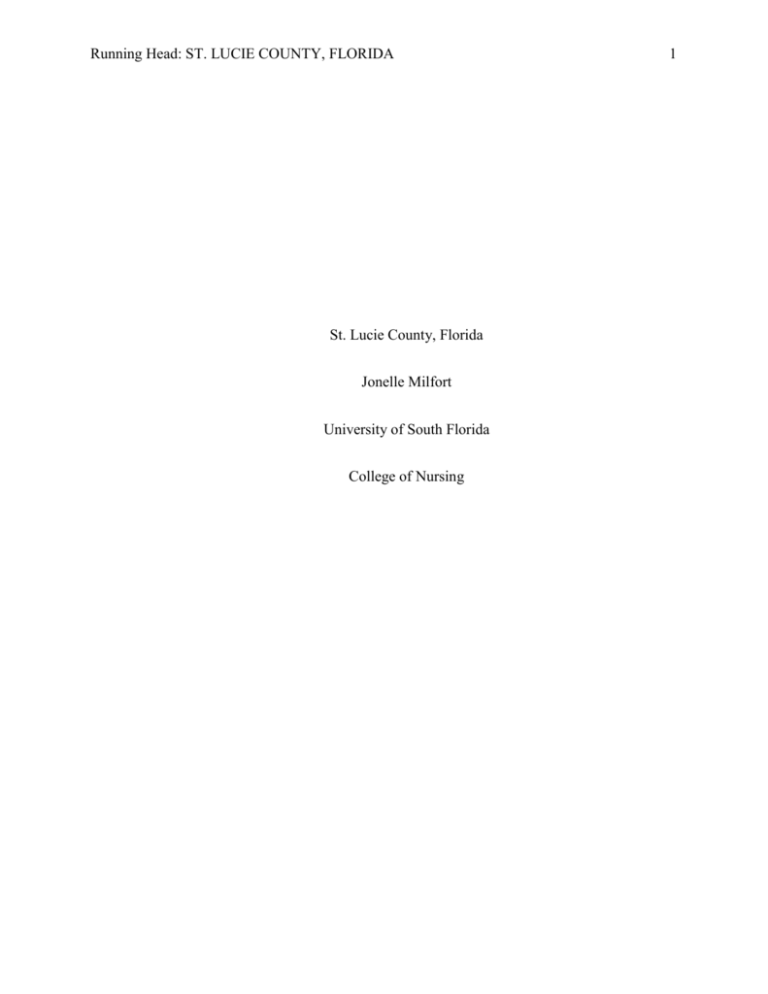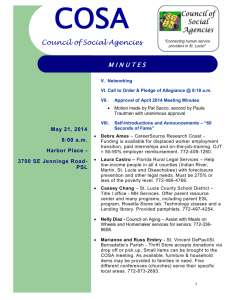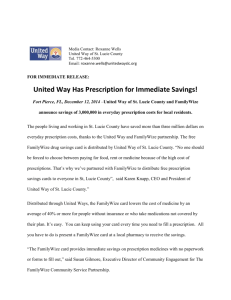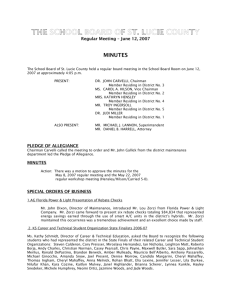File - Jonelle Milfort
advertisement

Running Head: ST. LUCIE COUNTY, FLORIDA St. Lucie County, Florida Jonelle Milfort University of South Florida College of Nursing 1 ST. LUCIE COUNTY, FLORIDA 2 Within a community, there are many aspects that contribute to the overall health. Certain health norms may make the community as a whole healthier, but other norms may just as easily bring the overall health of the community seem less healthy. As a community health nurse, it is important to understand which of these norms may be influencing the health of the patient. With this understanding will come the ability to better care for and hopefully eventually heal the patient. St. Lucie County is a very urban area in the state of Florida with a population of 277,789 as of the 2010 census, and an area of 688 square miles. According to Florida Research Coast, as of 2008, the three major employers in St. Lucie County are the St. Lucie County School District, Wal-Mart/Wal-Mart Distribution Center, and Liberty Medical Supply with 4,000, 2, 105, and 1, 670 employees respectively (Major Employers, 2008). The St. Lucie County Chamber of Commerce states that there are currently five hospitals in the county including Lawnwood Regional Medical Center and Heart Institute which is the main hospital used by the residents. There are four assisted living facilities: The Brennity at Tradition, The Lynmoore, Harbor Place at Port St. Lucie, and The Palms of St. Lucie West. (St. Lucie County Chamber of Commerce, n.d.). County Health Ranking states the ratio of primary care physicians to patients is currently 2,620 to 1 compared to a lower ratio of 1,426 to 1 statewide. The ratio of dentists to patient is also high currently being 2,958 to 1 with the ratio statewide being 1,981 to 1. The rate of those uninsured in St. Lucie County is higher than the state percentage with 27% compared to 25%. However, St. Lucie County is better than the state in one aspect, that being preventable hospital stays. In 2013 there were 53 preventable hospital stays in St. Lucie County compared to 64 cases statewide (County Health Rankings & Roadmaps, 2014). ST. LUCIE COUNTY, FLORIDA 3 In the years of 2008-2012, the percent of families below the poverty level in St. Lucie County was 16.6 % compared to a much lower percentage of 15.6 statewide. It was also learned that only 84.2% of the population over the age of 25 have a high school diploma in St. Lucie County compared to that of the state percentage of 85.8%. St. Lucie County also has a low percentage of people over the age of 5 that speak another language other than English at home with 20.9% compared to the 27.3% statewide (St. Lucie County, Florida, n.d.). The Centers of Disease Control and Prevention states smoking is the leading preventable cause of death in the United States. (Smoking & Tobacco Use, n.d.). It has also become one of the leading causes of lung cancer. In St. Lucie County, the percentage of adults who smoke is 16% compared to the 18% statewide, with the top U.S. performers being at 14%. Violent crime can also contribute to the health of a county. No matter how healthy a person is, they cannot account for the decisions of others being the victim of a violent crime can sometimes end a life. There are 418 documented cases of violent crime in St. Lucie County this past year compared to the much higher 556 cases statewide. Another facet of health in which St. Lucie County excels is in the amount of reported cases of sexually transmitted infections per year. This past year there were 347 cases in St. Lucie County compared to 399 statewide (County Health Rankings & Roadmaps, n.d.). STI’s are often a silent killer and the Centers of Disease Control and Prevention states about 19 million new cases are reported each year (2010 Sexually Transmitted Diseases Surveillance, n.d.). Without proper testing, many people may not know they have one until it is too late. With so many positive percentages and statistics, it is implausible that there would not be some with a downside. One of which being adult obesity. As a nation, the United States is getting bigger with approximately 34.9% of the country being obese (Overweight and Obesity, ST. LUCIE COUNTY, FLORIDA 4 n.d.). In St. Lucie County the percentage stands at 29% compared to 26% statewide. A statistic the goes hand and hand with obesity is physical inactivity with 26% of the county being inactive compared to 24% statewide. There has also been some studies into the correlation between unemployment and weight gain (County Health Rankings & Roadmaps, n.d.). Forbes magazine said that “many newly unemployed Americans find themselves gaining a significant chunk of weight after their losing their jobs” (Casserly, 2010). St. Lucie County’s unemployment rate is currently at 11.1%, significantly higher compared to the 8.6% unemployment rate of the state (County Health Rankings & Roadmaps, n.d.). St. Lucie County has both good and bad health aspects to its health system. However, the facet it has to work hard to change is its high rate of obesity and physical inactivity. Obesity and physical inactivity are gradually becoming one of the nation’s biggest problems and a leading factor in both cardiovascular diseases and diabetes. It is sweeping through the nation leaving behind diseases, complications, and sometimes even death in its wake, and if the something does not change for the citizens of this county, they will be next. The World Health Organization states the determinants of health include the social and economic environment, the physical environment, and the person’s individual characteristics and behaviors (The determinants of health, n.d.). These three categories are very broad and under them fall many other determinants that may contribute to the overall health of a person. Using these groups and sub-groupings, the Community Health Nurse can then develop interventions to address an issue. For example, on the topic of obesity, the Community Health Nurse may address dietary practices and exercise in the community. However, the nurse would also consider genetics and which people have a family history of obesity. ST. LUCIE COUNTY, FLORIDA 5 In the case of many diseases, people who are obese may be influenced by many outside and inside factors including human biology, environment, and lifestyle. An article was written concerning obesity and the widespread belief of Americans that obesity was caused by overeating and underexercising (Jou, 2014). This is, however, somewhat wrong. According to the article, in 1907 Carl von Noorden, a German pathologist, came to the reasoning that there are two types of obesity: exogenous and endogenous. Exogenous obesity is what most people suffer from, caused by poor nutrition and little to no exercise. Endogenous obesity is caused by hypometabolism and other problems that are thyroid oriented (Jou, 2014). In St. Lucie County, the population diagnosis is: Adults who live in St. Lucie County are at risk for cardiovascular disease and diabetes related to obesity as evidenced by 29% of the population being obese. To help find a plan to treat we would start with the primary Level of Prevention. This would be an outreach program, the locating of populations-of-interest or populations-at-risk and providing information about the nature of the concern, what can be done about it, and how services can be obtained (Public Health Interventions, 2001). This would be done on the community level. Outreach is a risk factor modification because of the act of finding those at risk and helping them make that first step towards recovery. This first level would involve the community members, health care providers, and funding sources. The community is who it is geared towards, health care providers can help identify at risk patients, and funding sources will help pay with the fees associated with finding these patients. The Secondary Level of Prevention would be health teaching, communicating facts, ideas and skills that change knowledge, attitudes, values, beliefs, behaviors, and practices of individuals, families, systems, and/or communities (Public Health Interventions, 2001). This would also be geared towards members of the community. This intervention would fall under ST. LUCIE COUNTY, FLORIDA 6 diagnosis and reporting. The outreach program would help identify at risk patients. This would help patients understand exactly what they have, if they are already obese or at risk for obesity. This would also help patients to understand the risks that coincide with obesity like diabetes. The community nurse would help organize an event that all the at risk patients can attend. The first goal is to instill in the community the urgency of lowering the rate of obesity. The Tertiary Level of Prevention is referral and follow-up, assisting individuals, families, groups, organizations, and/or communities to identify and access necessary resources to prevent or resolve problems or concerns (Public Health Interventions, 2001). This would be on an individual level because each person is very different in what they need to get better. With the referral and follow-up, the community nurse would be monitoring compliance, monitoring treatment effects, dealing with consequences, and preventing further negative impact on health all at once. The follow-up and referral will affect community members, health care providers, and funding sources. The World Health Organization defines health policy as decisions, plans, and actions that are undertaken to achieve specific health care goals within a society (Health policy, n.d.). With health policy comes the order to change and improve health care. In the case of St. Lucie County, the health policy proposed would be to identify those with, and those at risk of having, obesity. Then the community health nurse would provide information about obesity and what obesity could put you at risk for. Lastly, and most importantly is the tertiary stage, the referral and follow-up. This would make sure that the patients are getting the care that they need and that they continue on the road to recovery. In the ideal community, every aspect of its health would be perfect. Instead, each community has to deal with parts of the community that are less than perfect. In St. Lucie ST. LUCIE COUNTY, FLORIDA 7 County obesity and physical inactivity are some of these parts. Hopefully, the community health nurse would be able to positively change some of the habits of their patients. With a change in the health of the individual patient will eventually come a change in the overall health of the community. With this, St. Lucie County will positively become a healthier place for people and for future patients. References Assisted Living Facilities. Health Care. Community Info. St. Lucie County Chamber of Commerce. (n.d.). Retrieved from http://www.stluciechamber.org/assisted_living_facilities.asp Casserly, M. (2013, April 30). Unemployment and Weight Gain. Forbes. Retrieved from http://www.forbes.com/2010/04/30/job-loss-weight-gain-self-esteem-forbes-woman-wellbeing-money.html CDC. Fact Sheet. Health Effects of Cigarette Smoking. Smoking & Tobacco Use. (n.d.). Retrieved from http://www.cdc.gov/tobacco/data_statistics/fact_sheets/health_effects/effects_cig_smoking/ #overview ST. LUCIE COUNTY, FLORIDA County Health Rankings & Roadmaps. (n.d.). Retrieved from http://www.countyhealthrankings.org/app/florida/2014/rankings/stlucie/county/outcomes/overall/snapshot Florida Research Coast. Major Employers. (n.d.). Retrieved from http://www.floridarc.com/index.php?submenu=CorporateCommunity&src=gendocs&ref= MajorEmployers&category=CorporateCommunity Jou, C. (2014). The Biology and Genetics of Obesity — A Century of Inquiries. The New England Journal of Medicine, 1874-1877. Retrieved from http://www.nejm.org/doi/full/10.1056/NEJMp1400613 Obesity and Overweight for Professionals: Data and Statistics: Adult Obesity - DNPAO - CDC. (n.d.). Retrieved from http://www.cdc.gov/obesity/data/adult.html St. Lucie County QuickFacts from the US Census Bureau. (n.d.). Retrieved from http://quickfacts.census.gov/qfd/states/12/12111.html STD Trends in the United States, 2010. (n.d.). Retrieved from http://www.cdc.gov/std/stats10/trends.htm "Wheel" Manual - Capacity Development - Office of Performance Improvement - Minnesota Dept. of Heath. (n.d.). Retrieved from http://www.health.state.mn.us/divs/opi/cd/phn/wheel.html WHO. The determinants of health. (n.d.). Retrieved from http://www.who.int/hia/evidence/doh/en/ WHO. Health policy. (n.d.). Retrieved from http://www.who.int/topics/health_policy/en/ 8






